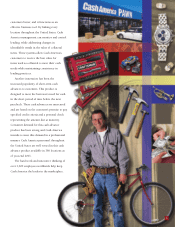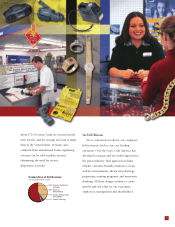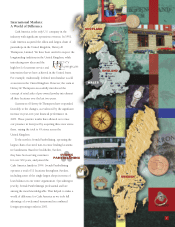Cash America 2001 Annual Report Download - page 17
Download and view the complete annual report
Please find page 17 of the 2001 Cash America annual report below. You can navigate through the pages in the report by either clicking on the pages listed below, or by using the keyword search tool below to find specific information within the annual report.
Income Taxes. The Company’s consolidated effective tax rate is impacted in
2000 by the effect of the valuation allowance provided for the deferred tax assets
arising from the Company’s equity in the losses of innoVentry. Including the
effect of the valuation allowance provided, the Company recognized no net
deferred tax benefits in 2000 from its equity in the losses of innoVentry. In 1999,
the effect of income taxes provided upon the deconsolidation of innoVentry was
the major item influencing the consolidated effective tax rate. Excluding the
effects of all items related to the Company’s investment in innoVentry after
deconsolidation and their related tax effects, the Company’s consolidated effective
tax rate increased slightly to 38.3% for 2000 from 38.2% for 1999.
Income from Continuing Operations. Diluted income from continuing
operations per share was $.03 for 2000, compared to $.15 for 1999. Excluding
various non-operating unusual items, adjusted diluted income from continuing
operations per share decreased to $.38 for 2000 from $.56 for 1999.
Supplemental information regarding the effects of the unusual items is as
follows (in millions, except per share data):
2000 1999
Income from continuing operations before income taxes $ 10.8 $ 13.3
Less unusual items —
Loss from operations of innoVentry
prior to deconsolidation —2.6
Gain from disposal of assets (9.7) (2.2)
Equity in loss of unconsolidated subsidiary 15.6 15.2
Gain from issuance of subsidiary’s stock (0.1) (5.2)
Income from continuing operations before
unusual items and income taxes $ 16.6 $ 23.7
Income from continuing operations after tax
excluding unusual items $ 9.9 $ 14.8
Income from continuing operations after tax
excluding unusual items per share – Diluted $ 0.38 $ 0.56
LIQUIDITY AND CAPITAL RESOURCES
Net cash provided by operating activities of continuing operations was $39.2 mil-
lion in 2001, $33.4 million in 2000, and $34.3 million in 1999. During 2001,
investing activities provided an additional $.8 million when the final payment of
insurance proceeds from the March 2000 tornado damage claim was received.
Financing activities also provided $12.3 million from net borrowings under the
Company’s bank lines of credit and $.3 million from other equity transactions.
In 2001, the Company utilized $3.2 million of cash to increase its pawn
loan and advances balances. An investment of $31.8 million in purchases of
property and equipment was made during 2001, including $11.0 million for
property improvements, the remodeling of selected operating units and additions
to computer systems for lending operations, $20.7 million for the reconstruction
of corporate headquarters property destroyed by the March 2000 tornado and
$.1 million in various fixtures and additions to Mr. Payroll’s point-of-sale software
system. The Company acquired 5 lending locations for $1.3 million and discon-
tinued operations utilized $2.9 million of cash during 2001, primarily for the
acquisition of tire rental stores earlier in the year. During 2001, the Company
also used cash to make scheduled payments of $9.8 million on debt obligations
in connection with unsecured notes and capital leases, pay $1.2 million in divi-
dends, and purchase $.6 million of treasury shares.
Management anticipates that the capital expenditure requirement for 2002
will be approximately $15.0 million. These expenditures will primarily relate to
10 to 15 new lending locations, the remodeling of selected operating units, and
enhancements to information systems. The new lending locations will mostly
occur through the acquisition of existing locations.
On October 26, 2000, the Company announced that its Board of Directors
authorized management to purchase up to one million shares of its common
stock in the open market. Under the authorization, the Company purchased
61,200 shares for an aggregate amount of $.5 million during 2001 and 700,900
shares for an aggregate amount of $3.3 million during 2000. Additional purchas-
es may be made from time to time in the open market and it is expected that
funding will come from operating cash flow and existing credit facilities.
The following table summarizes the Company’s contractual obligations at
December 31, 2001 and the effect such obligations are expected to have on its
liquidity and cash flow in future periods, assuming that the company’s lines of
credit are not renewed or extended in future periods (in millions):
Other
Lines Long-term Non-cancelable leases
of credit debt for continuing operations Total
2002 $ — $ 9.0 $ 20.3 $ 29.3
2003 112.6 12.6 16.2 141.4
2004 — 8.4 11.1 19.5
2005 — 8.3 6.5 14.8
2006 — 8.3 3.8 12.1
Thereafter — 12.6 8.2 20.8
Total $112.6 $ 59.2 $ 66.1 $237.9
At December 31, 2001, $100.0 million was outstanding on the Company’s
$150 million U.S. line of credit. In addition, the Company’s £20 million
(approximately $29.1 million at December 31, 2001) multi-currency line of cred-
it in the United Kingdom had balances outstanding of £2.7 million (approximate-
ly $3.9 million at December 31, 2001) and SEK 90.5 million (approximately
$8.7 million at December 31, 2001) related to operations in the United Kingdom
and Sweden, respectively. While the Company’s lines of credit mature during
2003, the Company expects to renew these credit agreements and extend the
maturity dates during 2002.
The credit agreements and the senior unsecured notes require the Company
to maintain certain financial ratios. The Company is in compliance with all
covenants or other requirements set forth in its debt agreements. A significant
decline in demand for the Company’s services would cause the Company to
reduce its planned level of capital expenditures and lower its working capital
needs in order to maintain compliance with the financial ratios in those agree-
ments. A violation of the credit agreements could increase the Company’s bor-
rowing costs and could even adversely affect the Company’s ability to renew
existing, or obtain access to new, credit facilities in the future. The Company
does not anticipate a significant decline in demand for its services and the
Company has historically been successful in maintaining compliance with and
renewing its debt agreements.
Management believes that borrowings available under these credit facilities,
cash generated from operations and current working capital of $174.6 million
should be sufficient to meet the Company’s anticipated future capital requirements.
QUANTITATIVE AND QUALITATIVE
DISCLOSURES ABOUT MARKET RISK
Market risks relating to the Company’s operations result primarily from changes
in interest rates, foreign exchange rates, and gold prices. The Company does not
engage in speculative or leveraged transactions, nor does it hold or issue financial
instruments for trading purposes.
Management’s Discussion and Analysis of Results of Operations and Financial Condition
15
























